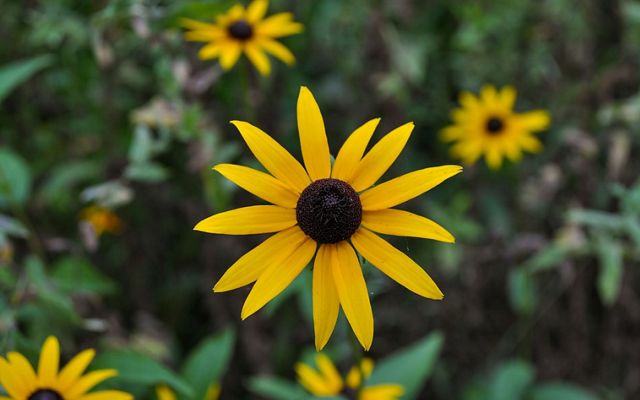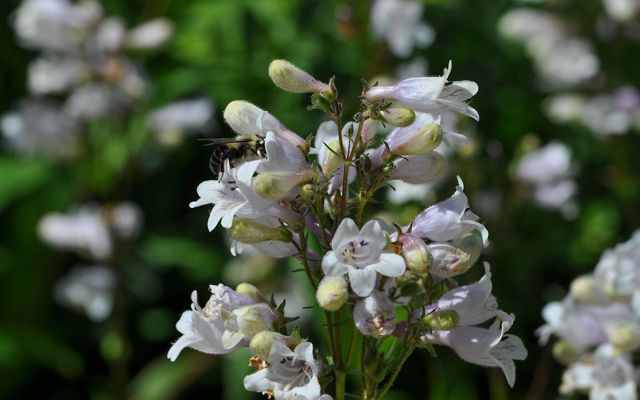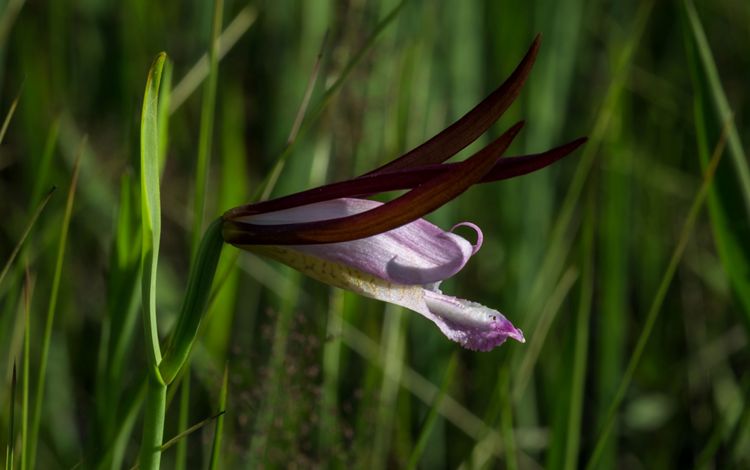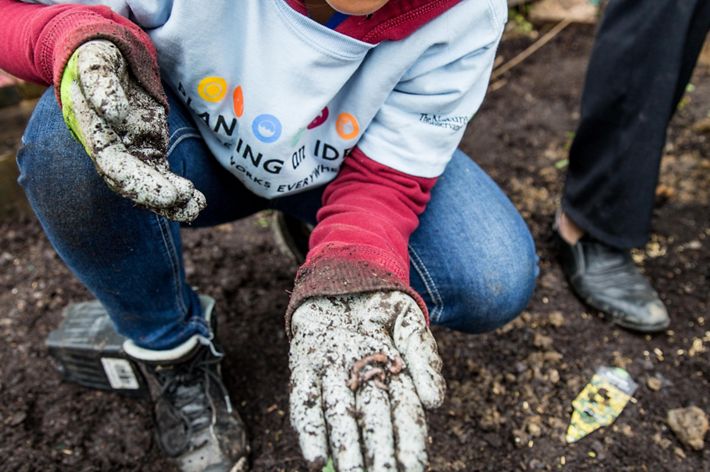Getting Started on Your Native Species Garden
This quick guide will help you choose native plants according to each region in North Carolina that support pollinators. Let’s get our hands dirty!
As the brisk winds of winter gradually yield to the gentle caress of spring, gardeners across North Carolina are looking to get their hands dirty. There is a lot to think about besides the beautiful blooming flowers when planning your garden. Pollinator species such as birds, butterflies and bees can benefit from having a cozy habitat in your yard. There are also things to watch out for, such as buying and planting invasive species that outcompete native species and harm the ecosystem. If you're gearing up to revitalize your garden this season, this is the perfect first stop to get all the information and tools you need.
Why Plant Native Species?
According to the North Carolina Botanical Garden, native plants are those that naturally occur and have evolved in a specific region over thousands of years. They are well adapted to the local climate, soil conditions and wildlife, making them resilient and low-maintenance choices for gardeners.
1. Biodiversity: Native plants support a diverse array of wildlife, including birds, butterflies, beesnand other pollinators. By cultivating native species, you create habitat and food sources for these important organisms, promoting a healthier and more balanced ecosystem.
2. Water Conservation: Native plants have deep root systems that help prevent soil erosion and improve water infiltration. They are naturally drought-tolerant once established, reducing the need for supplemental watering (saving water, yay!).
3. Low Maintenance: This is a big one if you don’t have much time to upkeep your garden. Unlike exotic or non-native plants, native species are well-suited to the local environment and require minimal upkeep once established.
North Carolina has diverse habitats, from the mountains to the coast, so you must pay close attention to which plant will be best for your location. We have selected a few native plant species that also benefit pollinator species so that you can create the perfect home for these creatures. Pollinators play a crucial role in the ecosystem by transferring pollen from one plant to another, facilitating the reproduction of many plants. Start creating a positive impact right from your backyard!

Pro Tip
Combine Nectar and Host Plants. Host plants are plants that insects live on and live off of during their first stages of life. Nectar plants are flowering plants that produce a sugary substance (nectar) that pollinators love to use as a source of energy during their adulthood.
Mountain Region
These plants thrive in the cool, moist conditions found at higher elevations.
Mountain Laurel (Kalmia latifolia): is a large shrub or small tree that thrives in acidic, well-drained soil and partial shade. It's important to plant it in a location where it has room to spread. Once established, it's generally low-maintenance but may require occasional pruning to maintain its shape. Mountain Laurel primarily serves as a nectar plant rather than a host plant. It produces beautiful clusters of flowers with nectar that attracts various pollinators, including bees, butterflies and hummingbirds.
Cardinal Flowers (Lobelia cardinalis): prefer moist, fertile soil and partial shade to full sun. It's relatively easy to grow from seeds or transplants and can attract hummingbirds and butterflies to your garden with its striking red flowers. It is primarily considered a nectar plant rather than a host plant.


Pipevine (Isotrema spp.): is a host plant for the Pipevine Swallowtail butterfly, who lay their eggs on the leaves of Pipevine plants, and the larvae feed on the foliage as they grow and develop. Pipevine is a twining vine with heart-shaped leaves and unique, pipe-shaped flowers. It prefers partial shade to full shade and well-drained soil.

Wildflowers in our preserves
Wildflowers bloom in the lower elevations of the mountains in early spring, typically around late March to early April. As you ascend to higher elevations, the blooming season may extend into late spring and early summer, peaking around May and June. Here are some flowers you can spot at Bluff Mountain and Bat Cave preserves.





Piedmont
These plants are well adapted to the moderate temperatures and clay soils of this area.
Black-eyed Susan (Rudbeckia hirta): is generally easy to grow and adaptable to a variety of soil types and light conditions. They prefer full sun but can tolerate partial shade. They are drought-tolerant once established and attract pollinators like bees and butterflies for their nectar.
Switchgrass (Panicum virgatum): is relatively easy to grow and is adaptable to a wide range of soil types, including poor or compacted soils. It prefers full sun but can tolerate partial shade. Once established, it is drought-tolerant and low-maintenance. A lot of pollinators rely on grasses for reproduction and food.


Butterfly Weed (Asclepias tuberosa): is easy to grow from seeds or transplants and is adaptable to a variety of soil types, including sandy or rocky soils. It prefers full sun and well-drained soil. Once established, it is drought-tolerant and attracts a wide range of pollinators. Butterfly weed is a host plant for the larvae of the monarch butterfly (Danaus plexippus). This plant species also serves as a nectar plant since it produces clusters of bright orange or yellow flowers that are rich in nectar and enjoyed by a variety of pollinators.
Download a Guide
Get this downloadable/printable, step-by-step PDF guide on how to plant your yard for pollinators.
Coastal Plain Region
These plants thrive in the warmer temperatures and sandy soils characteristic of this region.
Swamp Milkweed (Asclepias incarnata): can tolerate a range of soil moisture conditions, from wet to moderately dry, making it adaptable to various garden settings. It produces clusters of flowers that attract butterflies, bees and other pollinators. As a host plant for monarch butterflies, Swamp Milkweed is an essential addition to pollinator gardens, supporting the lifecycle of these iconic insects. Swamp Milkweed is primarily a nectar plant, providing a rich source of nectar for a variety of pollinators, including butterflies, bees and other insects.
Beardtongue (Penstemon spp.): are known for their tubular flowers that attract hummingbirds, bees, and other pollinators for their host plant benefits. They come in a variety of colors, including shades of pink, purple, red, blue and white. When planting Beardtongue in a garden in the coastal plain region of NC, it’s essential to choose species or cultivars that are native and well-adapted to the region.
Carolina Jasmine (Gelsemium sempervirens): is adaptable to a range of soil types, including sandy soils commonly found in the coastal plain, but it does require regular watering, especially during dry periods. When planting Carolina Jasmine in a garden, it's essential to choose a location with well-drained soil and full to partial sun exposure. It is also important to note that all parts of the Carolina Jasmine plant are toxic if ingested, so it should be planted with caution, especially in areas frequented by children or pets. It produces fragrant yellow flowers that attract a variety of pollinators, including bees, butterflies, and hummingbirds, with its abundant nectar.


Wildflowers in our preserves
Wildflowers at the Green Swamp Preserve and Calloway Forest Preserve are fire-adapted species. Control burning helps them because it clears the ground and allows them to receive direct sunlight, have fewer pests and have less competition for nutrients.



Native Trees
Eastern Redbud (Cercis canadensis): is a versatile tree that thrives in full sun to partial shade and tolerates a range of soil types, including well-drained soils common in mountainous areas. Additionally, Eastern Redbud adds aesthetic value to the landscape with its heart-shaped leaves and attractive pea-like flowers, making it a popular choice for both gardeners and wildlife enthusiasts. Its flowers make it an ideal nectar tree for pollinators.
Pawpaw Trees (Asmina triloba): prefer rich, well-drained soil and are typically found on woodland edges, along streams, and in other moist, fertile areas. They thrive in temperate climates with mild winters and warm summers. In North Carolina, Pawpaws can be successfully cultivated in both the mountainous regions and the Piedmont areas. These trees are considered host plants because they provide habitat and food for a variety of wildlife, including insects, birds and mammals.
Tulip-trees (Liriodendron tulipifera): are versatile and adaptable trees that can be planted across North Carolina, although they are more common in the mountains. They typically prefer well-drained soil and full sun to partial shade. Tulip-trees produce large, showy flowers that are attractive to bees, butterflies and other pollinators that feed off their nectar.


Wildflowers in our preserves
Wildflowers at the Outer Banks bloom from late spring through early fall. This timeframe typically spans from May to September, with peak bloom times varying depending on the specific species of flowers. Here are some wildflowers you can spot at Nags Head Woods Preserve.



Keep Digging Information!
For more resources on native plants, you can visit the North Carolina Botanical Garden to download invasive species toolkits and lists of additional native plant species. Additionally, consider participating in the Bird Friendly Habitat Certification Program offered by the New Hope Audubon. Through this program, experts will visit your property to identify both native and invasive plants and provide guidance on creating a habitat that is safer and more welcoming for wildlife. If you're eager to contribute to the recovery of native plants across the state, The North Carolina Native Plant Society offers various activities and events for participation. By selecting native plants that are well-suited to your region of North Carolina, you can create a beautiful and sustainable garden that celebrates the state's rich botanical heritage. So, roll up your sleeves, dig into the earth and let the beauty of native plants flourish in your garden this season.
Nature Right to your Inbox
Sign up to receive monthly conservation news and updates from North Carolina. Get a preview of North Carolina's Nature News email.



